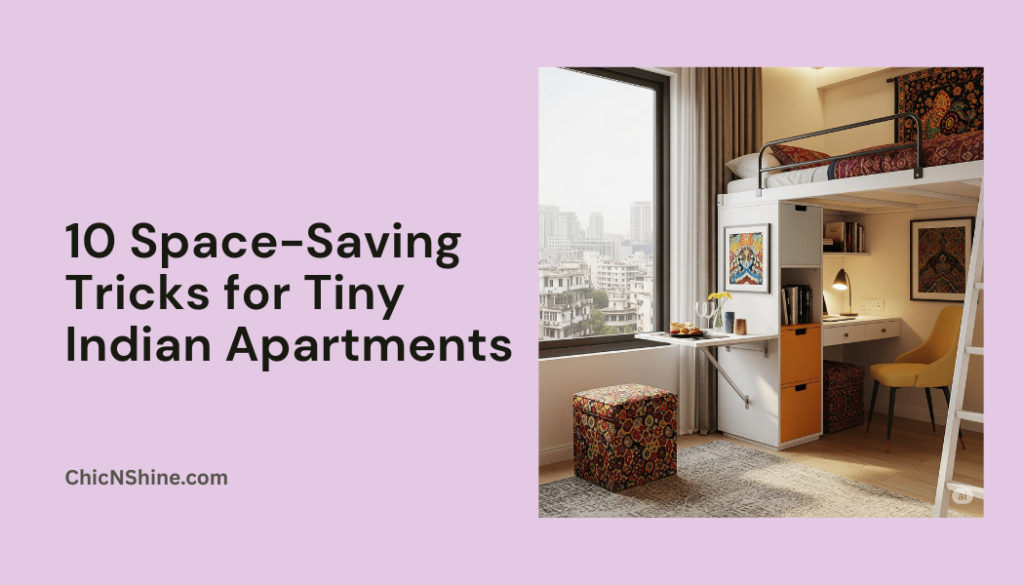Living in a compact space has taught me that mastering small apartment organization hacks in India requires creativity, cultural understanding, and practical solutions that work with our lifestyle. After struggling with my 450-square-foot apartment in Mumbai for two years, I’ve discovered ingenious ways to maximize every inch while maintaining the functionality that Indian households demand. My journey from cluttered chaos to organized bliss has been transformative, and I want to share these game-changing techniques that have made my small space feel surprisingly spacious.
The unique challenges of organizing Indian apartments go beyond just size constraints. We need storage solutions that accommodate everything from large cooking vessels and multiple sets of crockery to seasonal clothing, festival decorations, and the tendency to store items “just in case.” Moreover, our homes often serve multiple purposes—the living room transforms into a guest bedroom, the dining area becomes a workspace, and every corner needs to be functional yet aesthetically pleasing.

Understanding the Indian Apartment Challenge
Indian apartments present unique organizational challenges that differ significantly from Western counterparts. Our homes typically lack built-in storage, have awkward layouts with long corridors, and need to accommodate extended family visits, religious ceremonies, and our general tendency to hold onto items with sentimental or potential future value. Through my own experience and observing countless Indian households, I’ve realized that effective organizations must respect these cultural nuances while maximizing functionality.
The monsoon season adds another layer of complexity to our storage needs. We require additional space for raincoats, umbrellas, and waterproof bags, and often need to protect items from humidity and moisture. Additionally, our cooking styles demand significant storage for various spices, lentils, grains, and the numerous vessels required for Indian cuisine. These specific requirements mean that generic organization advice often falls short for Indian homes.
My approach to small apartment organization hacks in India has evolved to embrace these challenges rather than fight them. Instead of trying to minimize our possessions to Western standards, I’ve focused on creating systems that accommodate our lifestyle while still achieving the spacious, organized feel we desire. This philosophy has led to solutions that feel authentically Indian while delivering international-level organizational efficiency.
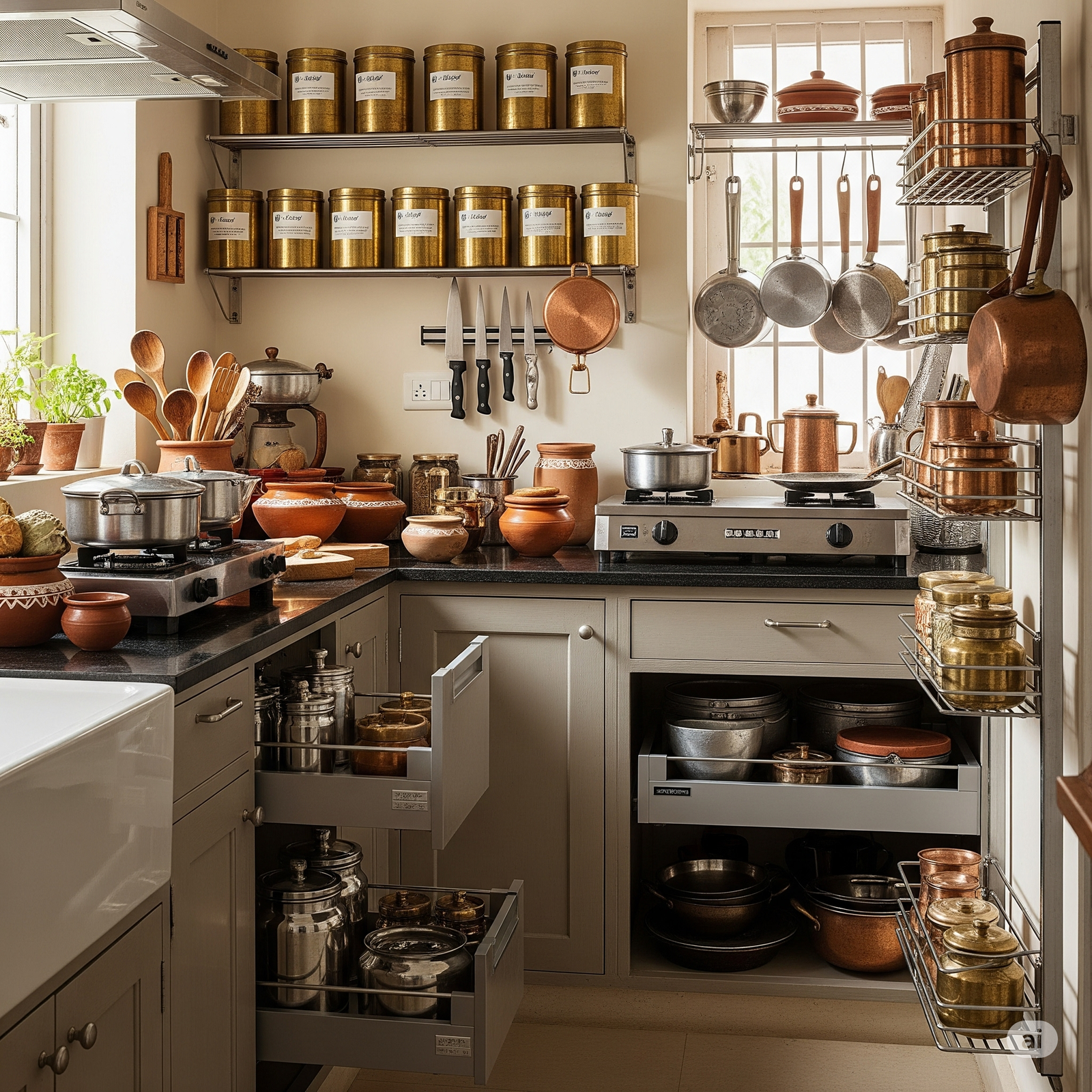
The Vertical Revolution: Going Up Instead of Out
One of the most transformative small apartment organization hacks in India that I’ve implemented is maximizing vertical space throughout my home. Indian apartments often have reasonable ceiling heights but limited floor space, making upward expansion the most logical solution. I’ve installed floor-to-ceiling shelving units that not only provide enormous storage capacity but also draw the eye upward, creating an illusion of height and spaciousness.
Wall-mounted storage has become my secret weapon for keeping surfaces clear while maintaining easy access to frequently used items. In my kitchen, I’ve mounted everything from spice racks to utensil holders, freeing up precious counter space for actual cooking. The key is using every available wall surface strategically—even the space above doorways and windows can accommodate lightweight storage solutions.
The transformation in my bedroom has been particularly dramatic. By installing wall-mounted bedside tables and floating shelves instead of traditional furniture, I’ve created the illusion of more floor space while increasing storage capacity. This approach works beautifully with Indian design aesthetics, allowing me to display traditional items like brass lamps and family photographs while maintaining functionality.
Smart Kitchen Organization for Indian Cooking
The Indian kitchen presents unique organizational challenges that require specialized solutions. My kitchen transformation began with the understanding that Indian cooking requires immediate access to numerous spices, oils, and cooking vessels simultaneously. Therefore, I’ve created a zone-based organization where similar items are grouped and stored in easily accessible locations within their respective preparation areas.
Spice organization has been revolutionary for my cooking efficiency. Instead of traditional spice boxes that take up counter space, I’ve installed magnetic spice containers on the side of my refrigerator and inside cabinet doors. This system keeps spices visible, accessible, and fresh while freeing up valuable cabinet and counter space. Additionally, I’ve designated specific areas for dry goods like lentils and grains, using airtight containers that stack efficiently and protect against pests common in Indian climates.
The transformation of my cooking vessel storage has been equally impactful. Indian kitchens require numerous pots, pans, and specialized cooking equipment like pressure cookers, idli makers, and various-sized tawas. I’ve implemented a drawer system with adjustable dividers that allow me to store these items vertically, making them easily accessible while maximizing storage efficiency. This approach has eliminated the frustrating experience of hunting through stacked pots to find the right vessel.
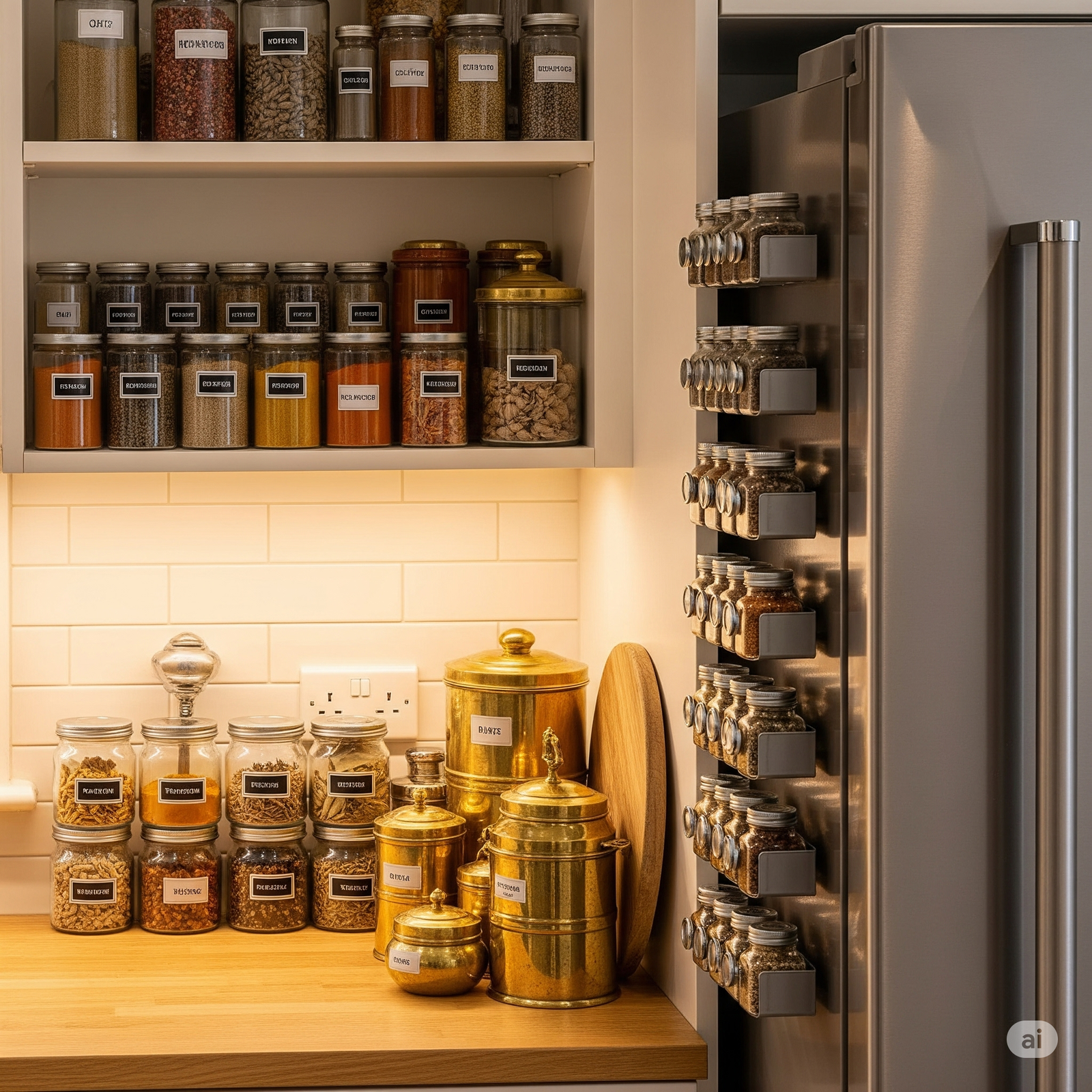
Bedroom Solutions for Multiple Functions
Indian bedrooms often serve multiple purposes beyond sleeping—they’re storage areas, dressing rooms, study spaces, and sometimes even temporary guest rooms. My bedroom organization strategy focuses on creating flexible systems that can adapt to these various functions while maintaining a peaceful, clutter-free environment conducive to rest.
Under-bed storage has become one of my most valuable small apartment organization hacks in India. I’ve invested in a bed frame with built-in drawers and supplemented it with rolling storage boxes that slide easily beneath the bed. This space now houses seasonal clothing, extra bedding for guests, and items I don’t need daily access to. The key is using transparent or labeled containers so I can easily locate items without disrupting the entire system.
Wardrobe organization has required a complete rethink of traditional approaches. Indian clothing includes various lengths and types—from sarees and salwar suits to Western wear and traditional accessories. I’ve implemented a double-rod system that maximizes hanging space, used shelf dividers to create designated areas for different clothing types, and installed hooks inside wardrobe doors for frequently worn items. This system accommodates our diverse clothing needs while making morning routines significantly more efficient.
Living Room Multifunctionality
The Indian living room needs to seamlessly transition between a family gathering space, entertainment area, guest sleeping quarters, and sometimes even a workspace. My living room organization focuses on furniture that serves multiple purposes while maintaining the welcoming atmosphere essential to Indian hospitality.
Storage ottomans have become indispensable in my living room setup. These pieces provide extra seating for guests while hiding away items like extra cushions, throws, and entertainment accessories. I’ve chosen ottomans that complement my existing furniture while offering significant storage capacity. Additionally, I’ve incorporated a storage coffee table that houses magazines, remote controls, and other living room essentials while maintaining a clean surface for entertaining.
The entertainment center organization has been crucial for maintaining a tidy living space. Indian homes often have multiple electronic devices, cables, and accessories that can quickly create visual clutter. I’ve used cable management solutions and storage boxes to keep all wiring hidden while ensuring easy access for maintenance. Moreover, I’ve designated specific storage areas for seasonal decorations and festival items that are essential parts of Indian celebrations but don’t need year-round display.
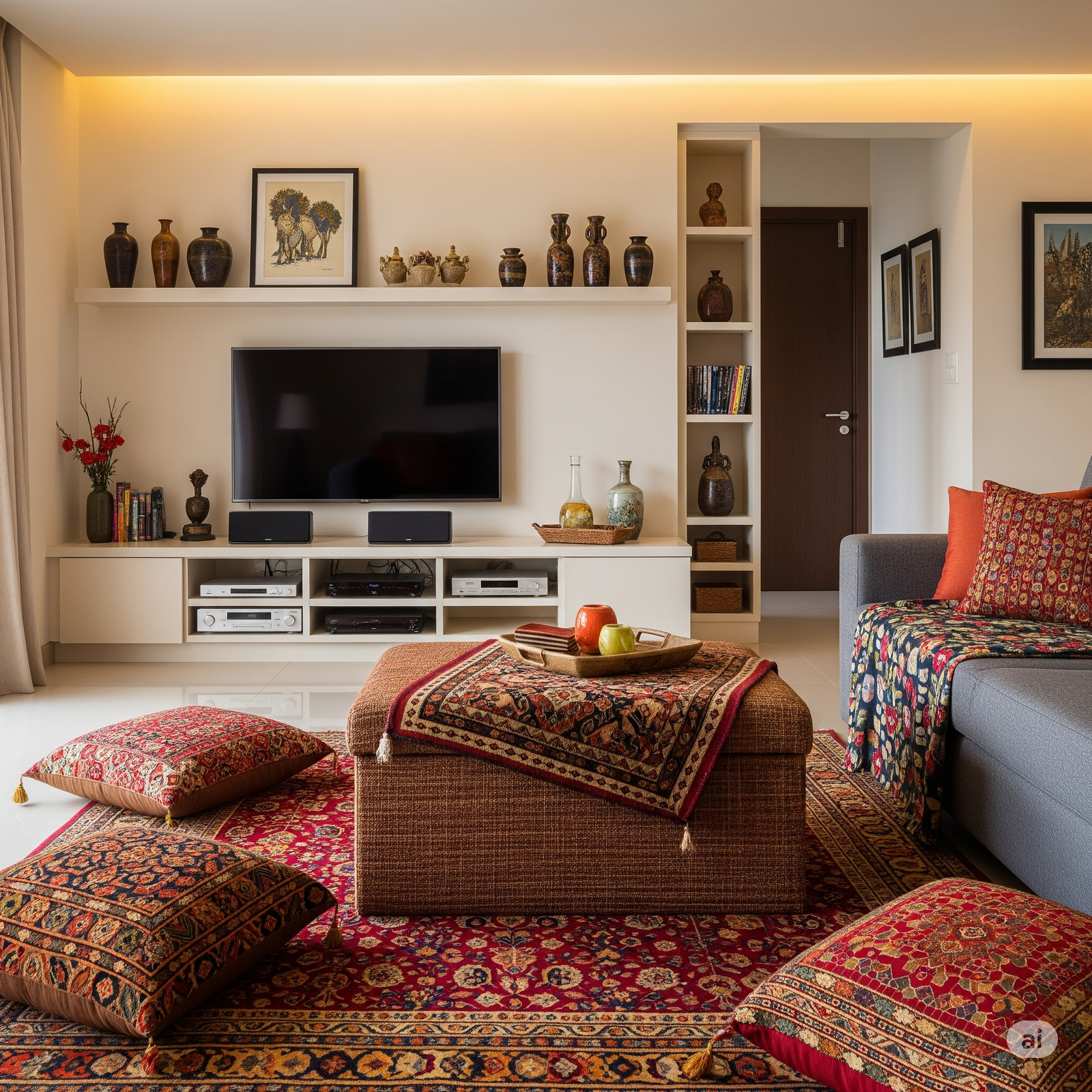
Bathroom Organization in Compact Spaces
Indian bathrooms are typically quite small but need to accommodate numerous personal care items, cleaning supplies, and often laundry-related equipment. My bathroom organization strategy maximizes every available surface while maintaining the hygiene standards essential in these spaces.
Over-the-toilet storage has been a game-changer for my bathroom organization. This often-overlooked space can accommodate shelving units that provide substantial storage for towels, toiletries, and cleaning supplies. I’ve chosen moisture-resistant materials that can withstand the humid conditions common in Indian bathrooms while providing easy access to frequently used items.
The shower and bathing area organization required particular attention to moisture resistance and quick-drying capabilities. I’ve installed suction cup organizers and hanging caddies that keep personal care items organized and accessible while allowing proper drainage and air circulation. These solutions prevent the buildup of soap scum and mildew that can be problematic in humid Indian climates.
Entryway and Foyer Efficiency
The entrance area of Indian homes needs to accommodate shoes, umbrellas, bags, and often religious items while creating a welcoming first impression for guests. My entryway organization balances functionality with the aesthetic appeal important for Indian hospitality.
Shoe storage has been particularly challenging given that Indian households typically remove shoes at the entrance and often have multiple family members with varying shoe sizes and types. I’ve implemented a combination of closed storage for everyday shoes and open shelving for frequently used footwear. Additionally, I’ve included storage for seasonal items like monsoon footwear and festival shoes that require specific accommodation.
The key hook and accessory organization has streamlined my daily routines significantly. I’ve installed multi-level hooks that accommodate different family members’ heights and needs, along with small storage baskets for keys, wallets, and other essentials. This system ensures that important items have designated homes while preventing the entrance area from becoming cluttered with daily necessities.
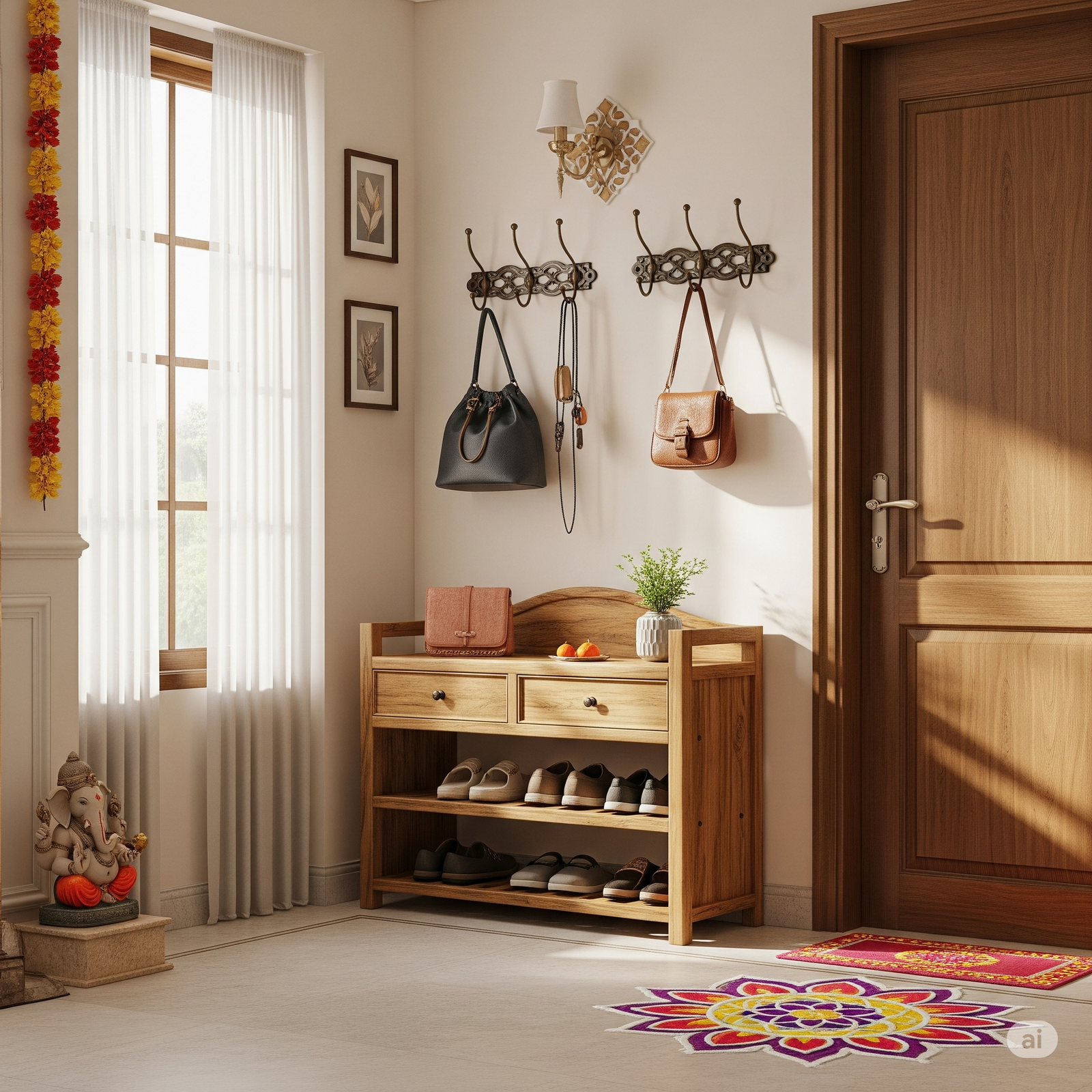
Balcony and Outdoor Space Optimization
Indian apartments often include balconies or small outdoor spaces that can provide valuable additional storage and functional areas when organized properly. My balcony transformation has created an extension of my living space while accommodating practical storage needs.
Weather-resistant storage solutions have been essential for maximizing balcony utility. I’ve installed weatherproof storage boxes that house seasonal items, cleaning supplies, and outdoor equipment while protecting them from monsoon rains and intense summer heat. These solutions have effectively expanded my apartment’s storage capacity without compromising indoor space.
The integration of plants and greenery has required specific organizational strategies that accommodate both aesthetic goals and practical maintenance needs. I’ve created vertical garden systems that maximize green space while including storage for gardening supplies and watering equipment. This approach has transformed my balcony into a peaceful retreat while serving practical organizational functions.
Technology and Cable Management
Indian apartments often have multiple electronic devices, entertainment systems, and the inevitable tangle of cables that can quickly overwhelm small spaces. My approach to technology organization focuses on hiding unsightly cables while maintaining easy access for maintenance and modifications.
Cable management systems have been transformative in creating clean, organized spaces throughout my apartment. I’ve used cable clips, cord organizers, and management boxes to route all wiring along walls and furniture edges, eliminating the visual clutter that can make small spaces feel even more cramped. This attention to detail has significantly improved the overall aesthetic of my home.
Device storage and charging station organization have streamlined my daily technology use while preventing surface clutter. I’ve created designated charging areas with built-in cord management that keep devices organized and easily accessible while maintaining clean surfaces throughout the apartment. This system accommodates the various devices common in modern Indian households while preventing the accumulation of charging cables and adapters.
Seasonal Storage Strategies
Indian households require significant seasonal storage capacity for monsoon gear, winter clothing, festival decorations, and seasonal cooking equipment. My seasonal storage strategy focuses on rotation systems that keep current-season items accessible while storing off-season items efficiently.
Monsoon preparation storage has become particularly important given the dramatic weather changes experienced in many Indian cities. I’ve designated specific storage areas for raincoats, umbrellas, waterproof bags, and moisture-protection supplies that can be quickly accessed when weather conditions change. Additionally, I’ve implemented systems that allow easy rotation of these items as the seasons transition.
Festival and celebration storage requires accommodation for decorative items, special cooking equipment, and traditional clothing that may only be used occasionally but hold significant cultural and sentimental value. I’ve created storage systems that protect these items while keeping them accessible for religious celebrations and family gatherings that are central to Indian culture.
Budget-Friendly DIY Solutions
Implementing effective small apartment organization hacks in India doesn’t require expensive purchases. Many of my most successful solutions have been created using affordable materials and simple DIY techniques that work particularly well with Indian household items and spaces.
Repurposing everyday items has provided numerous storage solutions throughout my apartment. Large pickle jars become excellent storage containers for bathroom supplies, old saree borders can be transformed into drawer liners, and traditional brass containers can be repurposed for modern organizational needs. This approach respects our cultural tendency to preserve useful items while creating functional storage solutions.
Custom storage solutions using locally available materials have proven both cost-effective and perfectly suited to Indian apartment layouts. I’ve created storage systems using bamboo, locally sourced wood, and traditional textiles that complement Indian interior design while providing modern organizational functionality. These solutions often cost significantly less than imported organizational products while offering superior cultural integration.
FAQs
What are the most essential small apartment organization hacks in India for beginners?
Start with vertical storage solutions and decluttering. Focus on maximizing wall space, using under-bed storage, and creating designated homes for frequently used items. These three strategies will make the biggest immediate impact in most Indian apartments.
How do I organize a small Indian kitchen with limited cabinet space?
Utilize wall space with magnetic containers and hooks, use cabinet door interiors for storage, and implement vertical storage for pots and pans. Focus on creating cooking zones where related items are stored together for maximum efficiency.
What storage solutions work best for monsoon season preparation?
Invest in moisture-resistant storage boxes, create designated areas near entrances for rain gear, and use vertical storage for umbrellas and raincoats. Ensure these items are easily accessible when weather conditions change quickly.
How can I make my small apartment feel larger while staying organized?
Use light colors, maximize natural light, keep surfaces clear, and choose furniture with exposed legs. Vertical storage draws the eye upward, while decluttering creates visual space that makes rooms feel larger.
